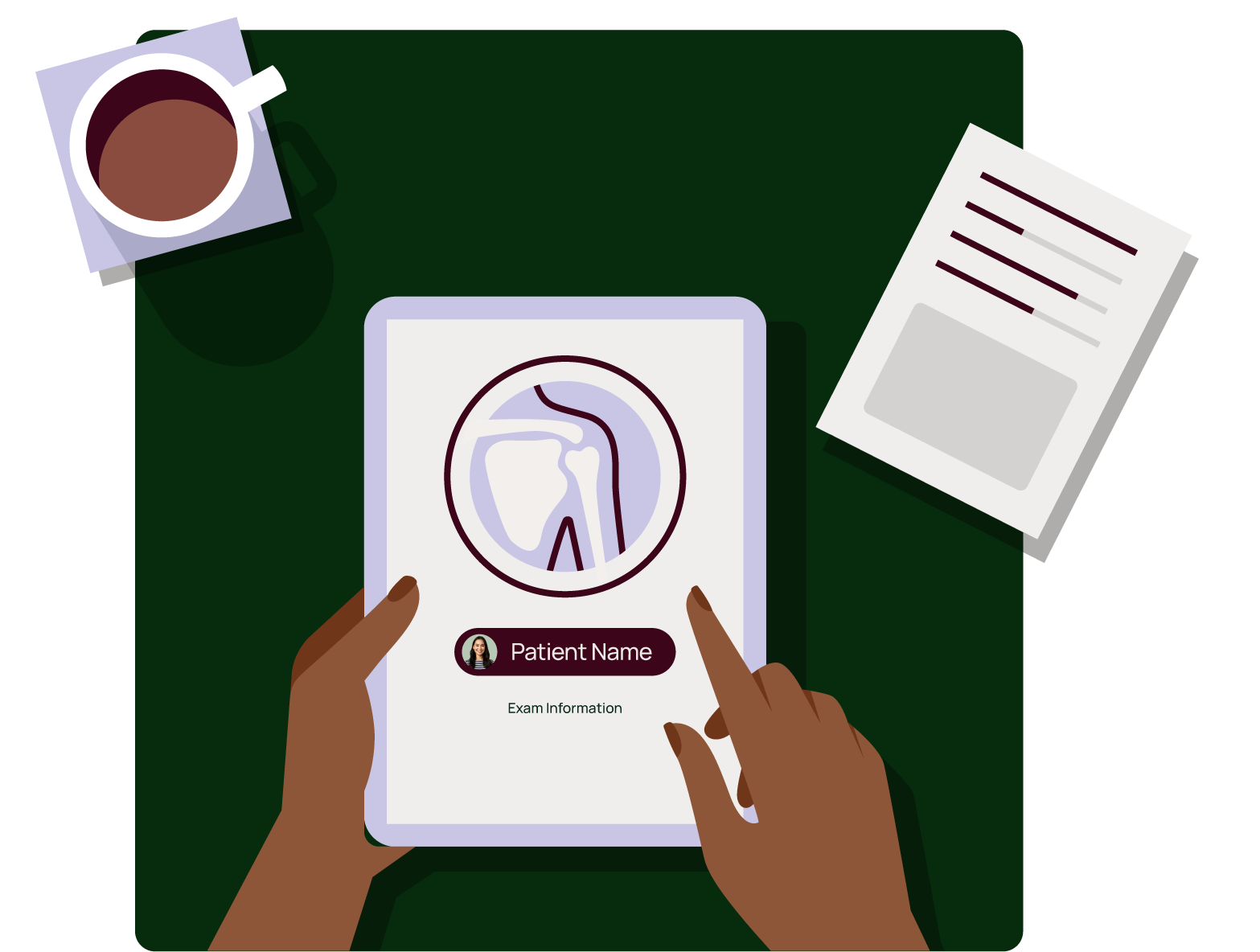September 13, 2024
Burnout is an escalating concern in the healthcare industry, driven by an increasingly aged population and short staffing. As the number of elderly patients rises, the demand for medical care increases, and the complexity of these cases rises as well. This increased demand puts undue pressure on physicians, often forcing them to work longer hours and accumulate more stress.
Recent statistics from Medscape reveal that Radiology ranks as the 7th most burnt out specialty when compared to 28 other physician specialties, with 54% of radiologists exhibiting burnout symptoms.
The implications of radiologist burn out extend past individual job satisfaction and work-life balance, negatively affecting the quality of patient care and increasing the likelihood of diagnostic errors. Technological solutions are emerging as an avenue for alleviating the burden on radiologists and ultimately improving their well-being.
How Can Administrators Help Reduce Burnout?
Addressing radiologist burnout requires approaches that alleviate as many pressures as possible that contribute to stress and exhaustion. Reducing administrative burdens is one way of reducing radiologist workload, which can be done by using innovative solutions that streamline or automate repetitive tasks. Giving radiologists access to advanced toolsets can improve diagnostic accuracy and reduce time-to-diagnosis. These technologies can simplify processes like reporting, sharing, case selection, and imaging analysis, freeing up valuable time.
Another strategy to reduce burnout is to allow for flexibility, specifically for case reading. Flexible work arrangements have been reported to improve job satisfaction by 20% leading to a healthier work environment, reducing the risk of burnout.
By prioritizing flexible, intelligent, and adaptable technology, the healthcare industry can take meaningful steps towards supporting radiologists and enhancing their work-life balance.
Centralize Your Imaging Platforms
One of the most impactful things that healthcare practices can do to help their radiologists save time is to centralize the workflow. Radiologists often face the “swivel chair” problem, where they need to physically rotate between multiple workstations, logging into different systems, and searching for the correct study to read. This fragmented process not only wastes valuable time but also creates unnecessary administrative burdens, reducing productivity. By consolidating imaging systems into a single, unified platform, radiologists can access all necessary imaging and information from one location.
Intelerad client Carolina Radiology Associates (CRA) faced significant operational challenges managing seven different workstations across various locations. After adopting IntelePACS in 2015, CRA consolidated their operations into a single workstation, vastly improving efficiency. Dean Doucette, CEO of CRA, noted that this change turned their system from inefficient to highly efficient “practically overnight.”
Leveraging integrated solutions like IntelePACS can help healthcare facilities create a more manageable work environment, supporting better outcomes for both patients and providers.
Ensure Equitable Workload Distribution
Workload for radiologists can vary day-to-day, leading to unpredictable and potentially unmanageable levels of stress. Managing caseload effectively can help mitigate this so work is evenly distributed among radiologists. By ensuring that radiologists receive cases matching their expertise and current capacity while still prioritizing critical cases, healthcare administrators can alleviate some of the pressures that lead to burnout.
In any radiology practice, there’s a tendency for “cherry picking,” where radiologists choose the easiest or highest reimbursement cases to complete from the worklist. This can leave more complex, higher acuity, or less desirable cases for others, creating an imbalance in workload distribution. While this can be unintentional, it leads to ineffective prioritization and may delay care for patients who require more immediate attention.
Solutions like InteleOrchestrator subvert this problem by intelligently prioritizing cases based on factors such as specialty, workload, and criticality. By ensuring that urgent cases receive immediate attention and that all cases are distributed equitably, InteleOrchestrator helps maintain a steady and manageable pace for all radiologists in the care team.
Effective case management helps prevent overload, reduces stress, and improves job satisfaction by balancing the workload more effectively.
Offer a Flexible and Intelligent Reading Experience
A flexible reading experience provides radiologists with more options for how and when they want to read cases. Remote reading capabilities allow radiologists to manage their workloads more effectively without having to spend long hours at the workplace. By offering the ability to read cases from home, radiologists can achieve a healthier work-life balance.
InteleViewer, Intelerad’s secure and feature-rich remote reading solution, enables radiologists to access and interpret cases from their web browsers, providing the freedom to work from various locations. The flexibility and ease of use offered by InteleViewer ensures that radiologists can perform their duties without being confined to the hospital or clinic, enhancing job satisfaction and reducing stress.
When integrated with InteleOrchestrator, the benefits are augmented. InteleOrchestrator’s auto-next reading feature takes the decision fatigue out of case management. intelligently prioritizing cases based on urgency, workload, and specialty, automatically presenting the next most appropriate case to the radiologist. By saving time on case selection and ensuring that critical cases are addressed promptly, auto-next reading helps radiologists tackle their workload more effectively and efficiently.
Leverage Advanced Tools
Advanced toolsets are another way we can make radiologists’ jobs easier. If we streamline the analysis process, we can save valuable time and improve diagnostic accuracy.
InteleViewer includes a comprehensive set of advanced visualization tools designed to facilitate rapid analysis of imaging studies. Tools like multi-planar reconstruction, maximum intensity projection, and volume rendering give radiologists the option to view and interpret images from different perspectives and depths. This advanced visualization capability improves precision and can lead to quicker detection of conditions.
InteleViewer also comes complete with automated measurements and annotation features, which reduce the time spent on manual calculations and documentation. The inclusion of auto-synchronization and hanging protocols ensures that images are consistently presented in a clinically relevant manner, along with priors for comparison.
By leveraging these advanced tools, InteleViewer helps radiologists conduct their analyses more efficiently, freeing up time and clicks that can be better spent on patient care. Diagnostic capabilities like these can contribute to creating a more manageable workload.
Automate Reporting Processes
Generating reports is another example of administrative work that can be automated. Often, all information needed for a report is available within the system, yet radiologists spend time compiling and formatting this data. By automating these processes, radiologists can save valuable time and focus more on diagnostic tasks and patient care.
Automated reporting can streamline various types of reports, from routine diagnostic summaries to compliance and quality assurance audits. InteleScreen offers 1-click MSQA audits, which allow radiologists to quickly generate MSQA compliance reports, automatically compiling and formatting all required data to regulatory standards.
Automating the generation of routine reports can ensure consistency and accuracy, while also freeing up radiologists to handle more complex cases. This reduces the cognitive load on radiologists and minimizes the risk of errors associated with manual data entry and report compilation.
Integrate 3rd Party Tools
By leveraging external solutions, healthcare providers can optimize their existing systems and introduce new functionalities that directly address the needs of radiologists. That’s why all Intelerad solutions have purpose-built integrations, to give radiologists access to any and all tools that make their job easier.
One powerful example is the integration with dictation software. When integrated with IntelePACS, dictation tools can be launched directly from the PACS interface, creating a frictionless experience for radiologists. This seamless integration means radiologists can dictate findings directly into the system without switching between different platforms or manually transferring data. This not only reduces the time spent on documentation but also minimizes errors associated with manual data entry and speeds up report generation.
Conclusion
Combating radiologist burnout is essential for maintaining high standards of patient care and ensuring the well-being of healthcare professionals. By implementing innovative solutions that make their lives easier, administrators can significantly reduce the pressures faced by radiologists on a day-to-day basis.
These strategies not only improve efficiency and diagnostic accuracy, but also enhance job satisfaction and reduce the risk of burnout. Intelerad’s suite of solutions, including IntelePACS, InteleViewer, InteleScreen , and InteleOrchestrator provide comprehensive tools to support radiologists in their workflow.
Empower your radiology team with the tools they need to deliver exceptional patient care and achieve a healthier work-life balance.
To learn more about how Intelerad’s solutions can help your practice combat radiologist burnout and improve efficiency, visit our product pages or schedule a demo today.





